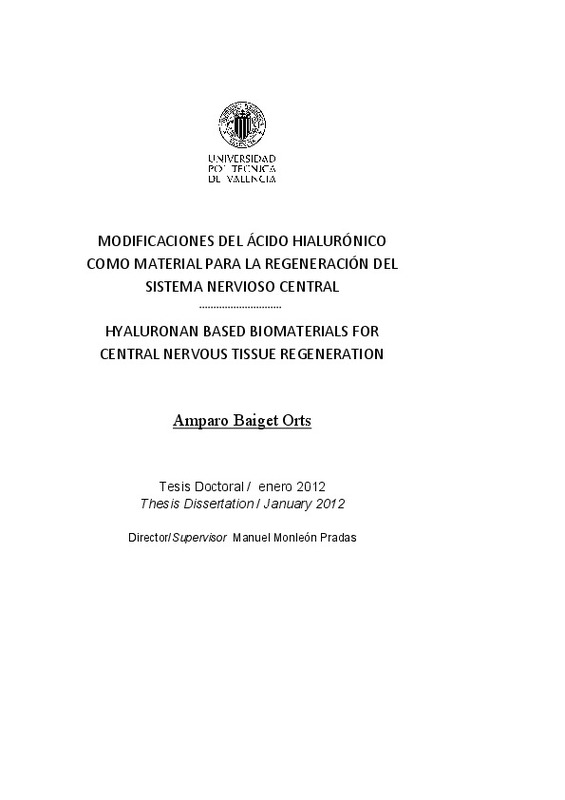- RiuNet repositorio UPV
- :
- Investigación
- :
- Tesis doctorales
- :
- Ver ítem
JavaScript is disabled for your browser. Some features of this site may not work without it.
Buscar en RiuNet
Listar
Mi cuenta
Estadísticas
Ayuda RiuNet
Admin. UPV
HYALURONAN BASED BIOMATERIALS FOR CENTRAL NERVOUS TISSUE REGENERATION
Mostrar el registro sencillo del ítem
Ficheros en el ítem
| dc.contributor.advisor | Monleón Pradas, Manuel
|
es_ES |
| dc.contributor.author | Baiget Orts, María Amparo
|
es_ES |
| dc.date.accessioned | 2012-01-27T10:11:59Z | |
| dc.date.available | 2012-01-27T10:11:59Z | |
| dc.date.created | 2012-01-13T09:00:00Z | es_ES |
| dc.date.issued | 2012-01-27T10:11:53Z | es_ES |
| dc.identifier.uri | http://hdl.handle.net/10251/14576 | |
| dc.description.abstract | The aim of this Thesis is to investigate the use of hyaluronic acid as a material for the design of scaffolds aimed at CNS regeneration. The motivation comes from the need of searching for new strategies that allow regeneration in the central nervous system. In degenerative diseases, such as Parkinson's disease, where the progressive loss of neuronal subpopulations occurs, a permissive environment able to support regeneration and connectivity of neurons from the host tissue may be a promising therapy to recover lost functionalities. In this Thesis we have focused on the development of structures able to integrate within the brain, supporting neural cells attachment and survival. We hypothesized that hyaluronic acid provides an enabling environment and appropriate for regeneration due to its biocompatibility and diverses physiological applications. Biocompatible hydrogels based on modified hyaluronic acid were synthesized. Covalently crosslinked hyaluronic acid hydrogels, alone or in combination with acrylic polymers, were synthesized and permitted to develop different porous structures which may serve in different applications as cell supply, cell repopulation or tissue regeneration. Highly porous with interconnected spherical pores, hollow tubes or multichanneled scaffolds were developed. The processes allow for a wide range of shapes for different applications within the scope of central nervous system regeneration. Furthermore, in vitro culture of human cell lines together with biomaterials was performed. A human microvascular endothelial cell line (hCMEC/D3) and a human glioma cell line (U373) were chosen for the studies. Experiments were focused on the interaction between hyaluronan based scaffolds and those cell lines composing the blood-brain-barrier (BBB) in the central nervous system. Biocompatibility, viability and phenotype characteristics were assessed. | es_ES |
| dc.language | Inglés | es_ES |
| dc.publisher | Universitat Politècnica de València | es_ES |
| dc.rights | Reserva de todos los derechos | es_ES |
| dc.source | Riunet | es_ES |
| dc.subject | Angiogenesis | es_ES |
| dc.subject | Biomaterials | es_ES |
| dc.subject | Hyaluronic acid | es_ES |
| dc.subject | Central nervous system | es_ES |
| dc.subject.classification | MAQUINAS Y MOTORES TERMICOS | es_ES |
| dc.title | HYALURONAN BASED BIOMATERIALS FOR CENTRAL NERVOUS TISSUE REGENERATION | |
| dc.type | Tesis doctoral | es_ES |
| dc.identifier.doi | 10.4995/Thesis/10251/14576 | es_ES |
| dc.rights.accessRights | Abierto | es_ES |
| dc.contributor.affiliation | Universitat Politècnica de València. Departamento de Termodinámica Aplicada - Departament de Termodinàmica Aplicada | es_ES |
| dc.description.bibliographicCitation | Baiget Orts, MA. (2012). HYALURONAN BASED BIOMATERIALS FOR CENTRAL NERVOUS TISSUE REGENERATION [Tesis doctoral]. Universitat Politècnica de València. https://doi.org/10.4995/Thesis/10251/14576 | es_ES |
| dc.description.accrualMethod | Palancia | es_ES |
| dc.type.version | info:eu-repo/semantics/acceptedVersion | es_ES |
| dc.relation.tesis | 3718 | es_ES |
Este ítem aparece en la(s) siguiente(s) colección(ones)
-
Tesis doctorales [5389]







![Text file [Text]](/themes/UPV/images/text.png)


